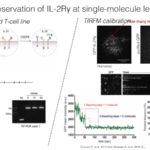Lien vers Pubmed [PMID] – 24349021
Lien vers HAL – hal-01406249
Lien DOI – 10.1371/journal.pone.0080914
PLoS One 2013 ; 8(12): e80914
One major question in molecular biology is whether the spatial distribution of observed molecules is random or organized in clusters. Indeed, this analysis gives information about molecules’ interactions and physical interplay with their environment. The standard tool for analyzing molecules’ distribution statistically is the Ripley’s K function, which tests spatial randomness through the computation of its critical quantiles. However, quantiles’ computation is very cumbersome, hindering its use. Here, we present an analytical expression of these quantiles, leading to a fast and robust statistical test, and we derive the characteristic clusters’ size from the maxima of the Ripley’s K function. Subsequently, we analyze the spatial organization of endocytic spots at the cell membrane and we report that clathrin spots are randomly distributed while clathrin-independent spots are organized in clusters with a radius of 2 μm, which suggests distinct physical mechanisms and cellular functions for each pathway.






